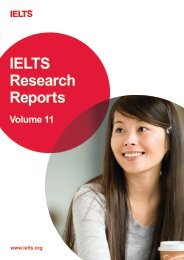6 The cognitive processes of taking IELTS Academic Writing Task 1
6 The cognitive processes of taking IELTS Academic Writing Task 1
6 The cognitive processes of taking IELTS Academic Writing Task 1
Create successful ePaper yourself
Turn your PDF publications into a flip-book with our unique Google optimized e-Paper software.
Guoxing Yu, Pauline Rea-Dickins and Richard Kielyattended intensive training courses and are not aware <strong>of</strong> the task requirement <strong>of</strong> “describing” only,they could be disadvantaged if they tried to integrate the information depicted in the graphs with theirprior content and graphic knowledge. Whether and to what extent reasonable “interpretation” shouldbe allowed in AWT1 writings have implications for comparability in marking. <strong>The</strong> participants’ strongview that interpretation <strong>of</strong> data is an integral and natural part <strong>of</strong> academic writing also oblige us toconsider the extent to which the AWT1 tasks mirror academic writing in target language use domains,for example, when describing and interpreting lab results.<strong>The</strong> findings <strong>of</strong> this research study are useful not only to language test providers and language testingresearchers, but also to intending <strong>IELTS</strong> candidates and English language pr<strong>of</strong>essionals and teachersto develop a greater understanding <strong>of</strong> the AWT1 tasks, as well as other language tests (listening,speaking and writing assessments) using graphs as prompts. It contributes to the development <strong>of</strong>theories and practices in foreign/second language writing, in particular, in relation to ourunderstanding <strong>of</strong> the roles that non-language knowledge and skills (ie, graphicacy) can play inlanguage assessments using visual input or data. In order to further develop our understandings <strong>of</strong>tasks using graphic prompts, we acknowledge several limitations <strong>of</strong> this research study and presenttwo pointers for future studies.Firstly, although sufficient training for think-aloud was provided to the participants in this researchproject, the effects <strong>of</strong> think aloud on test performance may never be removed completely, it isimportant to examine in detail the extent to which think-aloud may have affected the participants’<strong>cognitive</strong> <strong>processes</strong> and their actual writing performances. Detailed discourse analyses on the changesbetween think-aloud protocols and what the participants finally put down in their writings would be auseful perspective to analyse the effects <strong>of</strong> think aloud on composition and more importantly on the<strong>cognitive</strong> <strong>processes</strong> <strong>of</strong> re-producing graph comprehension. Investigation <strong>of</strong> content coverage would beanother useful perspective to understand the <strong>cognitive</strong> <strong>processes</strong> <strong>of</strong> AWT1 tasks, for example, what isincluded and what is not included, how and why, and the extent to which the inclusion or exclusion isrelated to the test takers’ English writing abilities and graph familiarity.Secondly, our analyses on the participants’ comprehension <strong>of</strong> graphic information did not focusspecifically on the sequence that the different graphic components were noticed and comprehended.Instead we focused on the participants’ overall comprehension <strong>of</strong> graphs. As Kennedy (1974) argued,“sometimes we read a label or caption before looking at the picture, but more <strong>of</strong>ten, probably, wenotice the picture first and recognise the pictured object without any help from the accompanyingwords” (p 7). Although our data indicated that the participants read or skipped the accompanyingtextual instructions before focusing on the graphs, it would be useful to systematically analyse whichgraphic components were noticed and comprehended first, and whether the comprehension <strong>of</strong> differentgraphic components was affected by the participants’ graphic skills and types <strong>of</strong> graphs. In addition, itwould be useful to investigate more precisely the timeline <strong>of</strong> AWT1 task completion, for example, thetime spent in reading and comprehending the graphs, time spend in re-producing the graphicinformation in writing, checking and re-checking understandings, and re-writing. Future studies mayexamine the sequence <strong>of</strong> comprehending graphic components, as the findings could have clearimplications for AWT1 task design.ACKNOWLEDGEMENTS<strong>The</strong> authors acknowledge the role <strong>of</strong> the <strong>IELTS</strong> Partners in making this study possible: <strong>The</strong> British Councilprovided the research grant which enabled us to conduct this study. Any opinions, findings, conclusions orrecommendations expressed in this report are those <strong>of</strong> the authors and do not necessarily reflect the views <strong>of</strong> theBritish Council, its related bodies or its partners.<strong>The</strong> authors acknowledge the administrative support <strong>of</strong> Zhejiang University. Special thanks are also due to thestudent participants who wish to be acknowledged by name, including Hu Zhinan, Li Kangkang, Li Wenting,Liu Yuguo, Ni Shuang, Zhang Kejun, plus others who wish to remain anonymous. <strong>The</strong>ir commitment andenthusiasm made this project possible.<strong>IELTS</strong> Research Reports Volume 11 © www.ielts.org 36
















